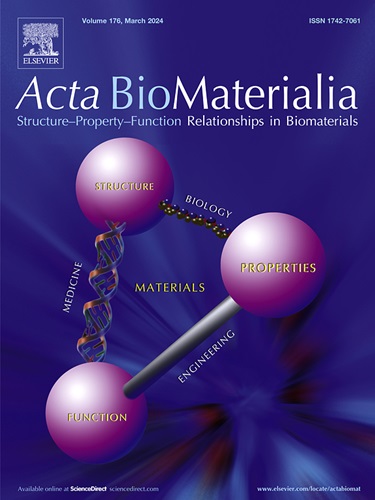Revisiting the physical and chemical nature of the mineral component of bone
IF 9.6
1区 医学
Q1 ENGINEERING, BIOMEDICAL
引用次数: 0
Abstract
The physico-chemical characteristics of bone mineral remain heavily debated. On the nanoscale, bone mineral resides both inside and outside the collagen fibril as distinct compartments fused together into a cohesive continuum. On the micrometre level, larger aggregates are arranged in a staggered pattern described as crossfibrillar tessellation. Unlike geological and synthetic hydroxy(l)apatite, bone mineral is a unique form of apatite deficient in calcium and hydroxyl ions with distinctive carbonate and acid phosphate substitutions (CHAp), together with a minor contribution of amorphous calcium phosphate as a surface layer around a crystalline core of CHAp. In mammalian bone, an amorphous solid phase has not been observed, though an age-dependent shift in the amorphous-to-crystalline character is observed. Although octacalcium phosphate has been postulated as a bone mineral precursor, there is inconsistent evidence of calcium phosphate phases other than CHAp in the extracellular matrix. In association with micropetrosis, magnesium whitlockite is occasionally detected, indicating pathological calcification rather than a true extracellular matrix component. Therefore, the terms ‘biomimetic’ or ‘bone-like’ should be used cautiously in descriptions of synthetic biomaterials. The practice of reporting the calcium-to-phosphorus ratio (Ca/P) as proxy for bone mineral maturity oversimplifies the chemistry since both Ca2+ and PO43- ions are partially substituted. Moreover, non-mineral sources of phosphorus are ignored. Alternative compositional metrics should be considered. In the context of bone tissue and bone mineral, the term ‘mature’ must be used carefully, with clear criteria that consider both compositional and structural parameters and the potential impact on mechanical properties.
Statement of significance
Bone mineral exhibits a unique hierarchical structure and is classified into intrafibrillar and extrafibrillar mineral compartments with distinct physico-chemical characteristics. The dynamic nature of bone mineral, i.e., evolving chemical composition and physical form, is poorly understood. For instance, bone mineral is frequently described as “hydroxy(l)apatite”, even though the OH- content of mature bone mineral is negligible. Moreover, the calcium-to-phosphorus ratio is often taken as an indicator of bone mineral maturity without acknowledging substitutions at calcium and phosphate sites. This review takes a comprehensive look at the structure and composition of bone mineral, highlighting how experimental data are misinterpreted and unresolved concerns that warrant further investigation, which have implications for characterisation of bone material properties and development of bone repair biomaterials.

重温骨骼矿物成分的物理和化学性质。
骨矿物质的物理化学特性仍然存在很大的争议。在纳米尺度上,骨矿物质既存在于胶原纤维的内部,也存在于胶原纤维的外部,作为不同的区室融合在一起,形成一个有凝聚力的连续体。在微米水平上,较大的聚集体以交错模式排列,称为交叉纤维镶嵌。与地质和合成羟基磷灰石不同,骨矿物是一种独特形式的磷灰石,缺乏钙和羟基离子,具有独特的碳酸盐和酸磷酸盐取代(CHAp),以及少量无定形磷酸钙,作为围绕CHAp晶体核心的表层。在哺乳动物骨骼中,未观察到无定形固相,尽管观察到无定形向晶体特征的年龄依赖性转变。尽管磷酸八钙被认为是骨矿物质前体,但在细胞外基质中除了CHAp之外,磷酸钙相的证据并不一致。与微岩石症相关,偶尔检测到镁whitlockite,表明病理性钙化,而不是真正的细胞外基质成分。因此,在描述合成生物材料时,应谨慎使用“仿生”或“类骨”等术语。报告钙磷比(Ca/P)作为骨矿物成熟度的代理的做法过于简化了化学,因为Ca2+和PO43-离子都被部分取代。此外,磷的非矿物来源被忽略了。应该考虑其他组合度量。在骨组织和骨矿物质的背景下,“成熟”一词必须谨慎使用,要有明确的标准,考虑成分和结构参数以及对机械性能的潜在影响。意义声明:骨矿物具有独特的层次结构,可分为纤维内和纤维外矿物区室,具有不同的物理化学特征。骨矿物质的动态性质,即演变的化学成分和物理形式,了解甚少。例如,骨矿物经常被描述为“羟基(l)磷灰石”,尽管成熟骨矿物的OH-含量可以忽略不计。此外,钙磷比通常被用作骨矿物质成熟度的指标,而不承认钙和磷酸盐位点的替代。本文综述了骨矿物质的结构和组成,强调了实验数据是如何被误解的,以及值得进一步研究的未解决的问题,这对骨材料特性的表征和骨修复生物材料的发展具有重要意义。
本文章由计算机程序翻译,如有差异,请以英文原文为准。
求助全文
约1分钟内获得全文
求助全文
来源期刊

Acta Biomaterialia
工程技术-材料科学:生物材料
CiteScore
16.80
自引率
3.10%
发文量
776
审稿时长
30 days
期刊介绍:
Acta Biomaterialia is a monthly peer-reviewed scientific journal published by Elsevier. The journal was established in January 2005. The editor-in-chief is W.R. Wagner (University of Pittsburgh). The journal covers research in biomaterials science, including the interrelationship of biomaterial structure and function from macroscale to nanoscale. Topical coverage includes biomedical and biocompatible materials.
 求助内容:
求助内容: 应助结果提醒方式:
应助结果提醒方式:


